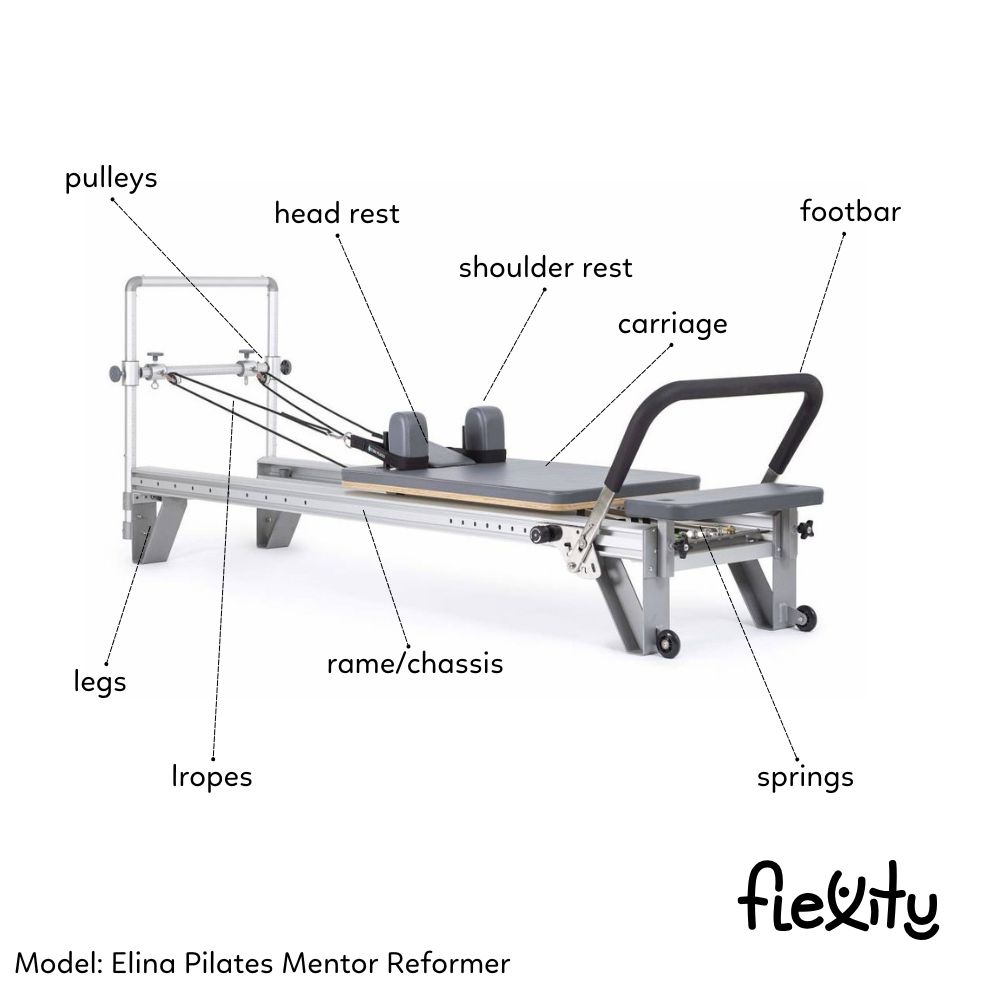Anatomy of Pilates Reformer Machines and Maintenance
We have prepared a comprehensive guide to help you familiarize yourself with the Pilates Reformer, highlighting key components to monitor and maintenance practices to ensure its longevity.
Anatomy of the Reformer Machine
While individual models may vary, the fundamental components often remain consistent. For better orientation, we include their English terms:

Basic Machine Setup Before Exercise
Before beginning your workout, ensure at least one spring is engaged to secure the carriage. Pilates Reformers Machines with higher legs facilitate easier mounting and dismounting.
Carriage Stopper:
- Determines how close the carriage gets to the platform.
- Position 1 is nearest to the platform; higher numbers (2, 3, etc.) are farther away.
- Avoid sitting on the carriage during adjustment.
- Remove all springs and insert the stopper into the desired position.
Tip: Typically, set the stopper so that when lying on your back with heels on the footbar, your hips are at a 90° angle. If you have any injuries or limitations, adjust the stopper accordingly.
Springs:
- The total resistance depends on the number of springs engaged.
- To increase resistance, attach the spring to a further notch on the gear bar.
- Place one hand on the gear bar for safety.
- Firmly grasp the spring and stretch it to hook or unhook.
Gear Bar:
- The position of the gear bar determines the initial tension of the springs. Lower positions indicate higher tension.
- Position 1 is closest; position 2 is farther, and so on.
- *Some machines may not have an adjustable gear bar.
Footbar:
- Adjustable to various heights.
- Depending on the model, adjustments can be made with one hand (pulling up) or two hands (pressing side levers).
Rope System:
- For proper rope length, place the handles on the carriage to align with the shoulder blocks.
Shoulder Rests:
- Removable for easier storage or to create a flat surface.
Headrest:
- Adjustable to three positions: flat, half-raised, or fully raised.
- Should be set to keep the neck and shoulders relaxed.
- For exercises where the hips are elevated above the shoulders, the headrest should be flat.
- In certain exercises, it's raised to support the feet.
Safety Check Procedures
Proper maintenance and timely replacement of equipment or its components help prevent injuries and machine damage. At least once a month, inspect the following areas:
- Ensure all spring locknuts and bolts are securely fastened.
- Confirm the footbar is firmly secured and remains stable during exercises.
- Examine all frame joints.
- Check for wear on all threads and replace if necessary.
- Inspect ropes and carabiners for wear; replace if needed.
- Verify that spring nuts, bolts, and ends are securely fastened and that springs are not deformed.
- Assess carabiners on both ends of the springs for wear; replace every 12 months or as needed.
- Look for spring deformation; replace every 24 months or as required.
- Avoid wearing jewelry or loose clothing that could damage upholstery or cause accidents.
- Ensure children do not access the equipment without supervision.
Cleaning and Regular Maintenance
- Make sure the soap doesn’t leave greasy residue or cause slippery surfaces.
- We do not recommend using chemical-based cleaning products.
- The inside of the aluminum rails and rollers should be cleaned weekly using window cleaner and a cloth.
- Spray the cleaner on the cloth first; avoid spraying directly on surfaces, rollers, or aluminum rails.
- Do not use lubricants on the wheels, as they can attract dust and lead to blockage along the rail.
- Never use oil-based lubricants as they may damage the rollers.
- Spray WD-40 Silicone on the springs to reduce clicking noises.
Cleaning Specific Components
General surfaces (metal and wooden parts, rails, pedals):
- Use clean water for regular cleaning of 90% of the surfaces.
- For tougher stains, mix 1 teaspoon of regular detergent with about 0.5 liters of water.
- Avoid aggressive cleaning agents that could leave a sticky surface.
Vinyl upholstery:
- Use a detergent-water solution (1:10 ratio). Do not use oils (e.g., Tea Tree, Peppermint) as they may dry out and damage the surface.
- Wipe the upholstery thoroughly and dry it afterwards.
Wheels:
- Clean wheels every 3 months and lubricate only with white lithium grease (available at auto shops).
- Remove the wheels, clean them, lubricate, and reattach. Do not apply lubricant directly to the surface of the wheels or rails.
Reformer rails:
- Use water with a few drops of detergent to clean black marks. For stubborn stains, you can use a gentle cleaning sponge.
Did this article help you? If yes, you can also help someone else by sharing this page. Feel free to share your experiences in the comments below the article and help others.

.jpg)